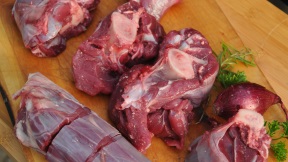
Wild approach
The recipes are a world away from standard goulash. “We take a creative and modern approach towards preparation instead of constantly firing up the overworked juniper cannon. For example, we like to use a blend of spices commonly used for barbecuing.” But the project also has a passion for revamping traditional recipes, such as Berghaus' grandmother's recipe for braised hare. The Wild Kitchen Project purposefully plays with the ambiguity of its name. “Wild” can also mean being adventurous, experimenting and using new techniques – a fundamental part of their recipe for success. “The haut gout, the typically strong flavour of game meat which used to develop as a result of prolonged ageing, is now no longer an inherent feature thanks to high hygiene standards. Game is a tender and delicious meat that can be prepared in many different ways using modern methods – whether that is sous vide, in a Dutch oven or simply on a grill,” insists Berghaus.
Forest dwellers meet pasture grazers
The inspiring success of the first book provided the basis for volume two: Wild Kitchen Project 2.0 was published in 2018 – “Wild & Weide” (Game & Graze). “With this book, we not only wanted to expand our niche, we also wanted to pay tribute to the work of selected farmers,” explains co-editor Berghaus. “There are farms in many regions that produce extremely high-quality meat while maintaining excellent welfare standards. This is another way to enjoy meat sustainably.” The positive feedback speaks for itself – book three is already in the works. Round three will feature wildlife in and around rivers. The first appetising glimpses into the new book will be available online in the coming months.
What does it encompass?
“Game” is a term that is used broadly in this project's cookbooks. Readers will also encounter unusual dishes such as raccoon goulash and heron breast tortilla. The idea of incorporating these recipes came about through a collaboration with Paul Parey publishing house, but they were right up the team's street. “This was the perfect next step for our sustainable utilisation concept. It gives meat from animals that were not originally shot for consumption a logical purpose,” explains Stephan Berghaus.






